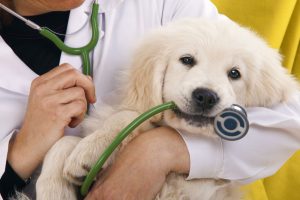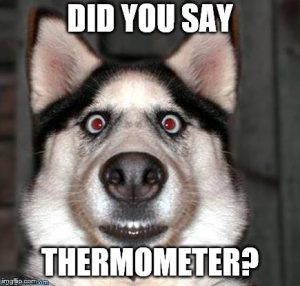Brave New World: Fear-Free Veterinary Visits
by CAROLINE COILE
 I sit in the waiting room with my dog, Luna. She is hyperventilating and shaking. Another dog lunges toward her and she tries to get away, but slips on the floor. We wait. She pants. We wait. She shakes. I question whether she would have been better off had I just tried to treat her at home. And I wonder when she started to be so frantic about going to the vet. Sadly, there are many candidate experiences. Way too many.
I sit in the waiting room with my dog, Luna. She is hyperventilating and shaking. Another dog lunges toward her and she tries to get away, but slips on the floor. We wait. She pants. We wait. She shakes. I question whether she would have been better off had I just tried to treat her at home. And I wonder when she started to be so frantic about going to the vet. Sadly, there are many candidate experiences. Way too many.
She’s not the only dog in the waiting room who seems to think she’s chained to the Titanic’s deck. There’s the dog acting like a drunk trying to ride a surfboard as he gets weighed. The one doing his plow imitation as he’s dragged to the exam room. The one in the back room apparently getting its leg amputated from the sounds of it—oh wait, turns out it was a nail trim. There’s only one optimist, a puppy looking bewildered at all the scared adults. “Just wait,” Luna seems to be telling him. “You’ll see. They’ll hold you down, cram a stick up your butt, pinch you a few times, cut your toes half off, and that’s just if you’re feeling good. If you’re sick, there’s no telling what tortures they’ll dream up.”

But it doesn’t have to be that way. Thanks to the Fear-Free revolution in veterinary medicine, that puppy may never have to shake and pant in the waiting room. The only pulling he may be doing is toward the exam room—that’s where all the fun and food is, right?
Founded by Marty Becker, DVM, Fear Free (whose motto is “Taking the pet out of petrified”) educates and certifies veterinarians and other pet professionals—including groomers, boarding kennel operators, trainers and handlers—in ways to create less stressful, happier experiences for pets in their care. Since Fear Free began offering certification in 2016, nearly 33,000 pet professionals have registered in the program.
BUT WHAT MAKES A VETERINARY PRACTICE FEAR-FREE?
Consider these suggestions:
- Let nervous patients wait in the car. Call the owner on their cell phone when it’s time to come in.
- Separate dog and cat waiting areas. Use room dividers if needed.
- Get patients into the exam room as soon as possible, even if it means waiting the same amount of time in the exam room instead of in the waiting room.
- Provide nonslip surfaces throughout. That may mean setting up runners or using replaceable carpet squares.
- Provide nonslip soft beds for dogs to lie down on. Better yet, have the owner bring one from home.
- Steady the scale. The unstable surface upsets some dogs. Weigh them in their carrier, or hold the scale as they step on it and release it only once they are secure.
- Play soothing music. Or even have a television running. It will sound more like home, help alleviate the owners’ nerves, and possibly help soothe the dog as well. In addition, it may help drown out barking and yelping of kenneled dogs or squealing of protesting patients. By the way, soundproof, soundproof, soundproof!
- Replace hospital odors with calming pheromones. Air out rooms to rid them of the scent of medical smells and scared-dog smells. Spray dog-calming (and human-calming) pheromones in the room and even on workers’ clothing.
- Be ready with a thunder coat—they aren’t just for thunderstorms. Many dogs find their slight squeeze comforting, and they can help calm a dog when at the vet. If the veterinarian doesn’t have some on hand, bring your own.
- Use treats, tricks and play to boost a dog’s spirits. Performing tricks for treats helps calm many dogs as it gives them something to focus on and also specific directions of what they should do. Using treats, toys and play helps convince the dog they’re in a fun place.
- Use persuasion rather than force. Lead a dog using a treat, not by dragging him,
- Use sedation when needed. Your dog is not going to become a drug addict if he has a doggy downer now and then. Giving him anti-anxiety medication not only helps him get through the current appointment but acts as a training tool so that his memories of past vet visits are good. If your dog needs a radiograph, it may be preferable to sedate him rather than have three techs dressed in lead wrestle him to the table. Nobody gets stressed or hurt and good views the first try!
- Know when to stop. For years we’ve been taught to push on through when our dogs fight us—that if we give in we teach our dogs that resisting pays off. That’s not good advice when it comes to a vet visit because the main thing it teaches him is learned helplessness—and the stress that comes with it. Telling him to man up relays to him that you, the one person he thought he could trust for his rescue, can’t even help in this chamber of horrors. Unless it can’t wait, just stop, reschedule the appointment to finish the procedure, and come sedated next time.
- Make procedures less aversive. Most dogs don’t particularly enjoy getting a thermometer shoved up their personal parts. Minimize discomfort (his, not yours) by dabbing a numbing agent on his rectal area a few minutes ahead of time, and by lubricating the end of the thermometer. Distract the dog with a tasty treat, preferably one like peanut butter or squeeze-cheese that takes a while to lick up.
- Examine dogs on the floor, with the veterinarian and owner also at their level. For small dogs, the examiner or owner can hold the pet in their lap. Wherever the dog is examined, he should be on a soft non-slip pad.
- Sit on the floor with the dog when possible. The fewer people looming over him the safer he will feel. Examiners shouldn’t immediately rush to the dog, but should instead start by talking to the client, ignoring the dog, even turning away from the dog, until the dog is comfortable with the new person in the room. Start the exam with gentle petting or grooming.
- Keep up a conversation between the people in the room, including especially the owner. This helps convince the dog everything is normal and you’re amongst friends.
- Consider examining especially fearful dogs outside. An enclosed patio area can combine safety while reducing stress.
- Dole out treats generously throughout the visit—not just at the end. It’s even better to make sure your dog is hungry beforehand.
- Allow owners to stay with their dog as much as possible. That may not be as convenient as having all surgery patients check in first thing in the morning so you can get to them as scheduling permits, but many dogs form their most terrifying impressions of the veterinary clinic from the experiences surrounding surgery. Many owners would gladly wait in the car with the dog for hours rather than have them quaking in a crate surrounded by barking dogs. And having the owner present as the dog is sedated and waking up can greatly calm the dog.

These are all great ideas, but wouldn’t they cost time and money? Vet visits are expensive enough without paying for extra sedation or return visits. But in fact, most fear-free practitioners report their clients are eager to do what it takes to make their dogs comfortable at the vet. And they say the extra time spent avoiding fear pays off in the time and manpower saved trying to restrain a fearful dog. Fear-free practices have found their business has grown as owners who have avoided taking their fearful dog to the vet are no longer apprehensive about doing so. It also pays off in terms of being happy on the job. Who wants to go to work knowing half your patients don’t want to see you? Most veterinarians chose their profession because they love animals; shouldn’t they get to spend their time interacting with them in a pleasant rather than adversarial way?
A fear free visit actually starts well before the first visit, and with the owner. A fear-free practice encourages you to bring your puppy in ahead of shot time just for treats and play. Practice the exam and even the pre-injection regimes at home. Practice tenting the skin over the withers, touching his feet with clippers, lifting his tail—all the while handing out treats like a broken vending machine.
To find a certified fear-free practitioner in your area, go to https://fearfreepets.com/resources/directory/. But don’t give up if there are none around. Suggest to your vet that you would love to see these techniques implemented. Many vets will be glad to adopt fear-free techniques with a few patients; when they see their success they may be on board with making their entire practice fear-free. Don’t forget there’s much you can do on your own in terms of training, preparing for the visit and simply knowing when to step in and be your pet’s advocate.
It is indeed a brave new world for our dogs. Human medicine embraced fear-free years, if not decades, ago, when they quit wrestling children to the metal exam table or started offering sedation for dental procedures. Why should our dogs, who understand even less why they are there, receive no less?
Short URL: https://caninechronicle.com/?p=148581
Comments are closed











